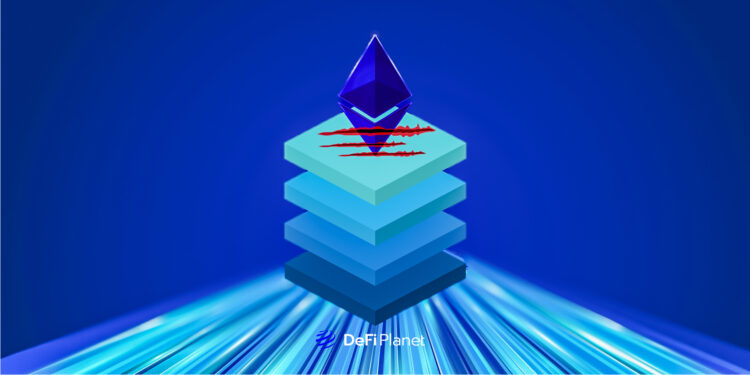Last updated on June 16th, 2025 at 07:54 pm
Ethereum’s dominance in the DeFi sector has long been contested by rival Layer 1 blockchains. However, it might just be the most significant challenge may not come from these external competitors but from within its own ecosystem.
A major way Ethereum is solving its inherent limitations—network congestion, gargantuan transaction fees and scalability issues—is via Layer 2 (L2) solutions such as Arbitrum, Optimism, zkSync, Base, and Polygon. These solutions offload transactional activity from the mainchain (Ethereum’s Layer 1) while leveraging its security guarantees. The consequence of this: Projects that previously sought refuge in Ethereum’s competitors are increasingly moving back to its Layer 2 solutions because of their enhanced functionality and lower operational risk.
But with this dynamic—ensuring Ethereum’s long-term viability while potentially diminishing the importance of Ethereum’s base layer for everyday users, L2 networks blur the lines between “Ethereum killers” and “Ethereum collaborators.” These scaling solutions are helping Ethereum scale and expanding in ways that might make them competitors rather than mere supplements; they carve out significant parts of the Ethereum user base and raise questions about the long-term viability of ETH.
So the question is: could the very tools designed to scale Ethereum eventually undermine its dominance?
Layer 2 Solutions Have Been Very Successful in Scaling Ethereum
Ethereum’s Layer 1 can process just 15–30 transactions per second (TPS), which often leads to congestion and high gas fees during periods of peak activity. However, with Layer 2 solutions, you get transactions completed in a fraction of that time and with less expenses.
Ethereum vs. Layer 2 Solutions

These performance gains have made L2 networks the go-to platforms for users priced out of Ethereum’s mainnet during periods of high activity. In essence, they enable Ethereum to retain its user base while expanding its reach to more cost-sensitive markets.
RELATED Scaling the Ethereum Blockchain: A Comprehensive Guide on Layer 2 Solutions
Another evidence of this is reflected in the rapid rise in the total value locked (TVL) of these platforms. Arbitrum, Optimism, Polygon, and Base all have TVL of over a billion dollars. These figures rival even established Layer 1 blockchains. Avalanche, for instance, currently has over$1.453 billion in TVL in its ecosystem with just over 399 protocols.
READ MORE: What’s Driving the Rapid Growth of Coinbase’s L2, Base?
Developer activity is flourishing on these platforms. Platforms like Polygon have attracted creators across gaming, DeFi, and NFT sectors, while Arbitrum and Optimism have become hubs for established DeFi protocols like Uniswap and SushiSwap.
Layer 2 Solutions Are Leaning Toward Independence. Scaling Partners Are Turning into Competitors
Layer 2 solutions are no longer defined solely by their role as Ethereum’s scaling partners. Instead, they are evolving into competitors with unique value propositions and robust ecosystems. These solutions are leaning towards becoming self-sustaining ecosystems. Considering their trajectory, it appears that it is the most logical thing to do—outgrow your predecessor.
Leading Layer 2 platforms are increasingly prioritizing interoperability and cross-chain compatibility, allowing them to operate more independently of Ethereum. Arbitrum, for instance, partnered with LayerZero, an omnichain interoperability protocol, to facilitate seamless cross-chain transfers. Similarly, Optimism enables users to connect to its mainnet from multiple blockchains through its dedicated UI. Polygon has taken things even further; it has since grown into a multi-chain network that can operate independently of Ethereum.
However, this independence comes with risks that could impact Ethereum’s ecosystem and the broader blockchain space.
Layer 2 platforms inherently depend on Ethereum’s security guarantees, but their specific implementations introduce unique vulnerabilities. Issues like smart contract bugs and bridging mechanisms pose significant risks. Any flaw in a Layer 2 protocol’s smart contracts could result in exploitation, compromising user funds, as we see in the October 2024 incident with Base. Also, the reliance on bridges to connect L2 networks to Ethereum or other chains creates attack vectors. History has shown that bridge hacks can result in significant losses, as seen in incidents like the Ronin Bridge breach.
The reduced reliance on Ethereum’s base layer could have significant implications for its native token, Ether (ETH). Staking is essential to the blockchain’s security apparatus, so ETH remains integral to the ecosystem, even as activity migrates to Layer 2 platforms. Also, transaction fees on these L2 networks are often settled in ETH, further reinforcing its role as the network’s foundational currency.
Yet, the growing independence of Layer 2 platforms could weaken this relationship. Some Layer 2 networks, like Polygon, have already introduced their native tokens, which are used for governance, staking, and sometimes transaction fees within their ecosystems. If this trend continues, the demand for ETH could wane as users and developers increasingly adopt Layer 2-native tokens. Also, its value as an asset might decline, potentially affecting its appeal as a store of value and investment vehicle. Furthermore, lower transaction volumes on Ethereum’s mainnet could decrease the amount of ETH burned through its fee mechanism, impacting its deflationary model and long-term scarcity.
READ MORE: Challenges and Opportunities for ETH in Scaling Ethereum
The Future of Ethereum and Layer 2 Networks
The evolving relationship between Ethereum and Layer 2 networks presents several potential scenarios, each with profound implications for the blockchain’s future.
Competition and Fragmentation
As Layer 2 networks become increasingly self-reliant, they may draw users and developers away from Ethereum’s base layer. This fragmentation could create silos within the ecosystem, limiting interoperability and reducing the overall effectiveness of Ethereum’s network. Competing for market share, Layer 2 platforms might prioritize their growth over Ethereum’s broader goals, potentially destabilizing its leadership in DeFi and beyond.
Ethereum’s ecosystem benefits from strong network effects, where the growth of one component strengthens the entire platform. However, the rise of independent Layer 2 networks could lead to ecosystem fragmentation. If users and dApps are dispersed across multiple platforms, Ethereum’s once-unified ecosystem may struggle to maintain cohesion and seamless interoperability—the next frontier in blockchain development.
Ethereum’s Dominance
Another scenario that could play out is that Ethereum eventually outgrows its need for these L2 solutions. The blockchain network is still in the “active development stage;” it has only completed four of its six-phased growth plans.
So, if the blockchain can consolidate activity back on its main chain, that’s a big win for it and a massive loss for these networks.
Symbiotic Growth
The previous scenario assumes that Ethereum’s ongoing and planned improvements will disrupt the current balance and not integrate seamlessly with the Layer 2 ecosystem. However, that might not be the case. Vitalik Buterin, the co-founder and probably the biggest stakeholder in the platform’s development, thinks that L2 networks are a very important part of the blockchain’s future.
So, the dream outcome is that the Ethereum and Layer 2 networks complement each other’s strengths in a symbiotic relationship. However, this scenario would require deliberate collaboration and the development of seamless interoperability to ensure mutual growth. Buterin knows this. In October 2024, while celebrating the blockchain’s existence and sharing his thoughts for the future, he emphasized how important it is to create a unified Ethereum ecosystem so that it feels like “one ecosystem, not 34 different blockchains.”
If this doesn’t happen, it might eventually become kill or be killed for all these networks, including Ethereum.
Final Thoughts
There is no doubt that Layer 2 solutions have been a game-changer for Ethereum; they have enabled it to scale and serve a broader audience. Yet, their evolution into independent ecosystems raises questions about Ethereum’s future. We have already explored how the broader competition from other Layer 1 blockchains could reshape the blockchain landscape in the coming years. The impact of these L2 solutions is another spoke in that dynamic.
Whether Ethereum and these networks remain allies, rivals, or something in between is still very unclear at present. Additionally, there is a lot of time for that to play out. The outcome will mostly depend on how both adapt to the rapidly changing demands of the blockchain industry. But what’s certain is that this dynamic interplay will continue to shape the future of decentralised technology.
Disclaimer: This article is intended solely for informational purposes and should not be considered trading or investment advice. Nothing herein should be construed as financial, legal, or tax advice. Trading or investing in cryptocurrencies carries a considerable risk of financial loss. Always conduct due diligence.
If you would like to read more articles like this, visit DeFi Planet and follow us on Twitter, LinkedIn, Facebook, Instagram, and CoinMarketCap Community.
Take control of your crypto portfolio with MARKETS PRO, DeFi Planet’s suite of analytics tools.”





















